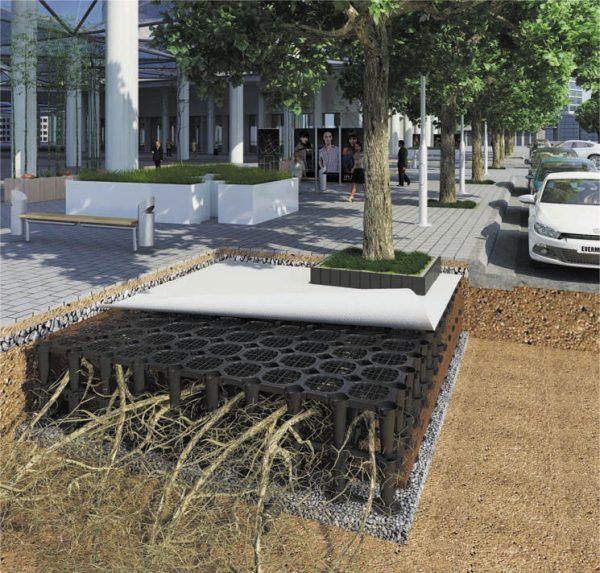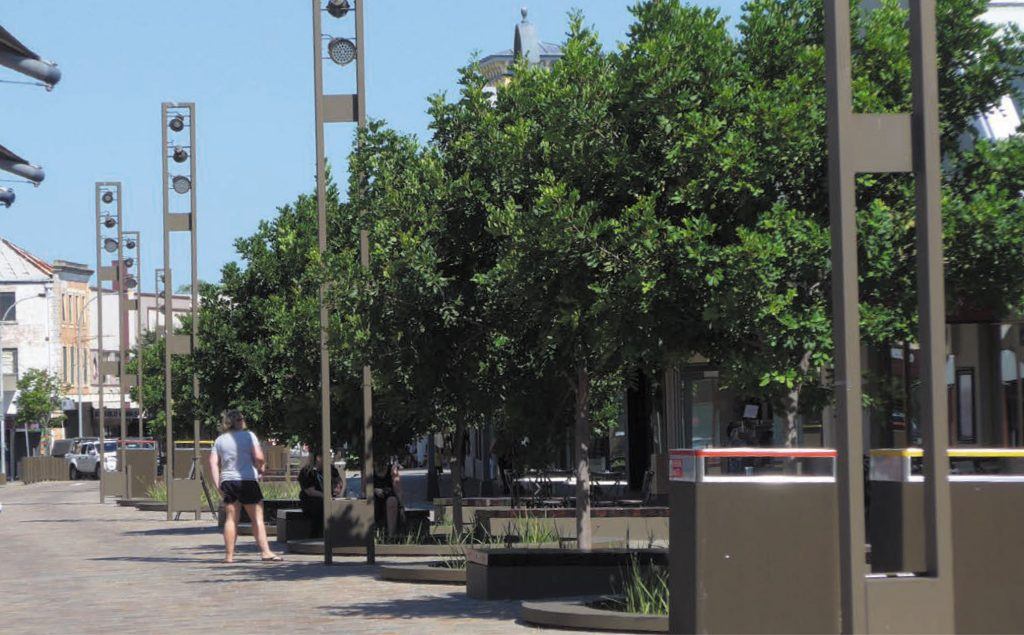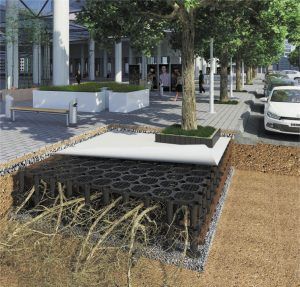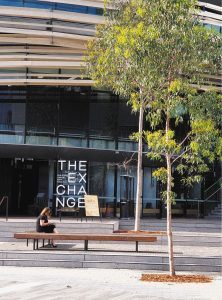
Fresh water is a finite resource, so a water tanker leaving Hepburn Shire every four hours is becoming quite a drain. With many regions affected by recent droughts and bushfires, it seems strange that 80 million litres of Australia’s water is bottled and shipped off each year (Elg, 2019). The sustainability of global ground water is a concerning issue as climate changes and rain events become more unpredictable. Urban environments rely on a matrix of impervious concrete pipes and channels to mitigate storm events, with runoff predominantly directed away from soils beneath the cemented membrane. More recent prioritisation of sustainable infrastructure such as rain gardens, bioswales and modified tree pits in urban planning aims to return large volumes of stormwater into urban soils through passive irrigation of landscape vegetation. The immediate benefits of such measures are obvious, but deployment is limited, and a lot of water still ends up in treatment networks.
In the Australian context, the use of water for irrigation of public assets will become less negotiable as the continent gets hotter and droughts become more frequent. Considering municipalities already require substantial amounts of water, future deployment of green infrastructure would complement the intrinsically grey network by reducing active irrigation of street trees, while cooling the urban heat island (UHI). Several tree-sensitive products are currently on the market for varied stages of tree maturity. We strongly recommend the consideration of permeable materials and sympathetic construction practices when designing around trees, particularly where upgrades to impervious infrastructure are anticipated.
If storm events are severe enough, the combined transport of residential, commercial and industrial wastewater can overflow into septic systems. A contemporary approach that utilises the benefits of both grey and green infrastructure would reduce the amount of water escaping from urban systems during rain events. Stormwater control measures (SCMs) are devices that ease the intensity of gutter flows by intercepting and partitioning water into reservoirs beneath street level, which are connected to adjacent tree pits and the surrounding soil. The water is primarily acquired by street trees with excess supply diffusing into the soil profile for ancillary uses. The extent to which these SCMs benefit the environment, community and the economy overall is likely understated.
Urban trees already interact with rainwater by intercepting falling precipitation, enhancing infiltration through root growth and bioturbation of soils, while filtering and returning water to the atmosphere through transpiration. In this article we propose that cultivating the most appropriate tree species and complementary understory plants deserves consideration to further improve the functionality of these SCMs, under current and future climate scenarios. The right tree planted with the right planning and protection will almost always lead to desirable outcomes in the long term.

Stormwater mitigation studies using modified tree pit SCMs reported varying levels of passive irrigation supply to subject trees (Daly et al., 2012; Grey et al., 2018; Szota et al., 2019). Despite some variation, the general theme is one of success with tree pit SCMs harvesting significant volumes of water for uptake by trees. As you would expect, less water was lost where an SCM was deployed. However, uptake of this water is ultimately determined by the performance of each tree and its microbial partners (Daly et al., 2012). The flow regime and residence time of water within each SCM will ultimately dictate what species can be planted and where, as waterlogging or drought stress will arise if calibration is not optimised. Larger trees transpire more water when compared to establishing counterparts, highlighting the importance of mature tree retention within urban landscapes to mitigate storm events. However, experimental plots in a United Kingdom study, using smaller trees, reduced runoff from asphalt surfaces by 62%, largely due to infiltration into modified tree pits (Armson, Stringer & Ennos, 2013). This supports the proactive and cyclic replacement of declining or poorly placed mature trees for the long-game approach. Further knowledge of amenity tree species’ influence on hydrology will be integral to managing tree pit SCMs effectively.
Complexity in the design of these SCMs might not even be necessary. Studies using more intricate designs reported 44% interception of runoff (Szota et al., 2019), where simpler harvesting models reduced runoff by up to 90% (Grey et al., 2018). The target being a return to more natural flow regimes with minimal wastage. Once developed into the mainstream, these SCMs will completely change the way our built environment stands within its footprint. Rehydrating soils through passive irrigation and alternative green infrastructure is a logical way to improve the productivity of urban environs.
There is even the possibility of tailoring green infrastructure to the needs of established trees, if proper planning and management is considered. Transplanting large trees is not a common practice in Australia but can provide an immediate mature landscape upon completion. Successful broadleaf and conifer transplanting projects occur frequently in the USA and Europe where there is appetite for instant landscapes. Trees grow in a delicate balance with their environment and considerable effort is required to maintain a tree in good vigour throughout its life cycle, particularly in the city. As urban spaces become more densely populated, planning and caring for mature trees must be a priority. Particularly as urban growing space comes at more of a premium with less of it available for replanting large species. It’s hard to imagine a small flat in the heart of the city making allowances for a 15m tree in a 2m x 4m courtyard, but it’s possible, and people are still happy to accommodate large trees within their design. But even the best laid schemes can have negative outcomes, and a concerted effort is required from planners, engineers and arborists alike to sustain urban forests into the future.

Big trees will always be necessary in urban spaces. They provide food and shelter for local fauna and services through cooling the built environment. But sustaining large urban trees in the face of climate change will be much harder as average temperatures increase. A recent projection of a 3°C rise under high carbon emissions estimated 73% of Australian native amenity trees would become unsuited to urban environments by 2070 (Burley, et al., 2019). Further to this, under similar dry climate scenarios, 25% of plants at The Royal Botanic Gardens of Victoria would become unviable by 2090 (Kendal & Farrar, 2017). Although the models have some unknown variables at play, it’s concerning to think that popular varieties may only be accessible to future generations in herbaria. The following five species are suited to Melbourne climate predictions for 2040, 2070 and 2090 (Kendal & Farrar, 2017, Burley et al., 2019). The shortlisted candidates are also selected for their size at maturity, as planting trees under powerlines can’t reasonably be expected to stop, despite the reminders. For that reason, some larger shrub varieties could be given the nod.
1. Brachychiton rupestris (Bottle Tree)
2. Callistemon citrinus (Scarlet Bottlebrush)
3. Callitris columellaris (Murray River Cypress)
4. Eucalyptus torquata (Coolgardie / Coral Gum)
5. Melaleuca bracteata (Black Tea-tree)
However, not all dry land specialists will respond favourably to increased water availability and planting exotic species will have merit where passive irrigation permits. In the United States, coniferous evergreen trees in California had a higher capacity for surface water storage compared to deciduous or evergreen broadleaf trees (Xiao & McPherson, 2016). Different tactics will be required when it comes to species selection but in any case, a permeable redistribution network that prevents waterlogging and sewer overflow while supporting a sustainable urban forest is an attractive concept. Where fast flowing stormwater is an encumbrance to the proper functioning of an SCM, complementary flow resistors upstream (i.e. bioswales) may improve the efficiency of each gutter inlet. The desire for productive green urban spaces warrants the prioritisation of permeable pavements and sympathetic tree planting methods to reduce water waste and boost resilience to climate change.
Despite growing interest surrounding trees in urban stormwater management, arboricultural challenges still arise considering the long-term viability of trees in urban spaces. Problems will continue to manifest from improper nursery practices and planting methods. Severe weather events and more commonly soil compaction, improper pruning, vandalism and root damage will always be a constraint to good plant performance. The addition of tree pit SCMs creates another dimension for urban foresters to comprehend, who are already expected to maintain canopy cover, defend against pest and disease arrivals, and the threat of significant weather events which are becoming more frequent. Where improvements to grey infrastructure are expensive or not successful at mitigating sewer malfunctions, green infrastructure systems are a sustainable alternative to harvest and redistribute stormwater.

Modified tree pit SCMs planted with an appropriate species would immediately improve water quality and boost the productivity of vegetation within a community. Trees are already widely accepted in urban areas and can be planted in a relatively small space when young. However, large-scale green infrastructure initiatives and mature tree transplanting may take longer to earn community support. Failure to achieve such ambitious goals will limit our ability to plant favourable species in the future. Incorporating green infrastructure as a standard has the potential to optimise our urban spaces and support a broader selection of plant species in the future. But we need to be hasty about it. There is enough talent and motivation out there to achieve great things. Leadership, however, is harder to find.
Research is quantifying the benefits of SCMs and despite some initial variation, the perceived advantages are promising. From an arboricultural perspective, incorporating SCMs into future developments is an effective way to harvest runoff and irrigate amenity trees, boosting plant productivity and ancillary community services in the process. Using permeable pavement options and sympathetic construction methods for development around trees is the most effective way to limit impacts and maintain vigorous canopy cover. Contemporary tree pit modifications will also provide a catalyst for limiting surplus energy from reaching the urban heat island by increasing shade and boosting rates of evapotranspiration. Promoting these pilot initiatives into the mainstream takes time and effort but there is considerable momentum to start acting upon. Improving water sustainability in urban centres must be a priority if future generations are to enjoy lush parks and gardens, in whatever form they eventually take. Under any circumstance, planting the right tree in the right place today with the right support and protection will result in profound benefits for those enjoying its services at maturity.*Article is independent research and as such unfunded.
Burley, H, Beaumont, LJ, Ossola, A, Baumgartner, JB, Gallagher, R, Laffan, S, Esperon-Rodriguez, M, Manea, A & Leishman, MR 2019, ‘Substantial declines in urban tree habitat predicted under climate change’, Science of the Total Environment, 685, pp.451-462.
Daly, E., Deletic, A., Hatt, B.E. and Fletcher, T.D., 2012. Modelling of stormwater biofilters under random hydrologic variability: a case study of a car park at Monash University, Victoria (Australia). Hydrological Processes, 26(22), pp.3416-3424.
Elg, H 2019, Residents concerned at amount of water being extracted for commercial sales, [online] The Courier. Available at: https://www.thecourier.com.au/story/6421840/residents-concerned-at-amount-of-water-being-extracted-for-commercial-sales/
Grey, V, Livesley, SJ, Fletcher, TD & Szota, C 2018, ‘Tree pits to help mitigate runoff in dense urban areas’, Journal of Hydrology, 565, pp.400-410.
Kendal, D & Farrar, A 2017, ‘Assessment of the climate change risk to the living plant collections in the Melbourne Gardens, Royal Botanic Gardens Victoria’. [online] Melbourne: Royal Botanic Gardens Victoria. Available at: https://www.rbg.vic.gov.au/plants-and-landscapes/landscape-succession-strategy/assessment-climate-change-risk.
Szota, C, Coutts, AM, Thom, JK, Virahsawmy, HK, Fletcher, TD & Livesley, SJ 2019, ‘Street tree stormwater control measures can reduce runoff but may not benefit established trees’, Landscape and Urban Planning, 182, pp.144-155.
Xiao, Q & McPherson, EG 2016, ‘Surface water storage capacity of twenty tree species in Davis, California’, Journal of Environmental Quality, 45(1), pp.188-198.